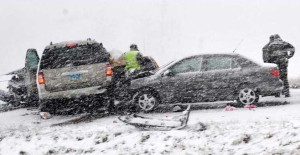North Dakota oil patch traffic fatality rate largely unchanged from a decade ago

By Rob Port | Watchdog.org North Dakota Bureau
STABLE FATALITY RATES: Traffic fatalities, particularly in North Dakota’s oil patch, have soared during the past decade. But so has the number of miles traveled, leaving fatality rate largely unchanged.
BISMARCK, N.D. — Some people are claiming North Dakota’s roads are getting more and more deadly as the oil-patch boom continues.
But when put into context with a rising number of miles traveled in the state, fatality rates are mostly unchanged from a decade ago.
Data provided by the North Dakota Department of Transportation from 2003 to 2012, the latest year for which data is available, show the number of traffic fatalities in North Dakota increased from 105 to 170 — more than 61 percent.
But the number of miles traveled on North Dakota roads also increased, going from more than 7.29 billion in 2003 to 11.881 billion in 2012, a 62 percent increase.
So the rate of fatalities per miles traveled on North Dakota roads remained relatively unchanged over the decade, going from 1.44 fatalities per 100 million miles traveled to 1.43 fatalities.
Even if the data is segregated into oil-producing counties and non-oil counties, the fatality rate remains stable.
Oil patch counties saw a 197 percent increase in traffic fatalities from 2003 to 2012, but also a 192 percent increase in vehicle miles traveled. The fatality rate for those counties increased slightly during the past the decade, from 1.46 fatalities per 100 million miles traveled to 1.49.
Outside of the oil patch, mileage was up 12 percent and fatalities were up 8 percent — an overall decrease in the fatality rate from 1.43 per 100 million miles traveled to 1.37.
But the national media uses different metrics to present a more sensational picture of oil patch traffic fatalities.
“In North Dakota drilling counties, the population has soared 43 percent over the last decade, while traffic fatalities increased 350 percent, to 63 last year from 14 ten years ago,” the Associated Press reported recently in an article headlined “Deadly side effect of fracking boom.”
“Roads in those counties were nearly twice as deadly per mile driven than the rest of the state,” the story reports.
But the AP used population growth to determine the rate of traffic fatalities, and that may not give an accurate picture of the problem.
“The average rate of deaths per 100,000 people — a key mortality measurement that accounts for population growth — in North Dakota drilling areas climbed 148 percent on average from 2009 to 2013, compared with the average of the previous five years,” reports the AP. “In the rest of the state, deaths per 100,000 people fell 1 percent over the same period.”
Counting population in North Dakota is tricky given the rapid growth of oil patch communities.
U.S. Census Bureau Director John Thompson recently visited the state to address the issue of getting an accurate population counts in a state where some communities have seen population double or triple in just a few years.
With population counts in question, using population growth as a metric to measure traffic fatalities seems ill-advised. Besides, many of the miles traveled on oil patch roads are put on by truck drivers and other motorists who don’t actually live in the oil patch.
That’s why the North Dakota Department of Transportation puts traffic accidents and fatalities in the context of the number of miles traveled on the roads, and based on that data North Dakota’s traffic fatality rates are largely unchanged from a decade ago.
Contact Rob Port at rport@watchdog.org
Category: News, North Dakota, transportation, Bakken, North Dakota Department of Transportation, oil







